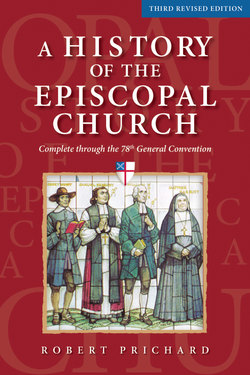Читать книгу A History of the Episcopal Church (Third Revised Edition) - Robert W. Prichard - Страница 11
На сайте Литреса книга снята с продажи.
ОглавлениеNOTES
1. “A the preceding a name [of institutions, groups, and companies] is lowercased in running text.” See Chicago Manual of Style on Line, sixteenth edition, 8.67, http://0-www.chicagomanualofstyle.org.librarycatalog.vts.edu/16/ch08/ch08_sec067.html (accessed February 17, 2014).
2. In the decade following the American Revolution, American Anglicans chose the name “The Protestant Episcopal Church in the United States of America.” This remains the official name of the denomination. The General Convention did, however, authorize the shorter title Episcopal Church as an alternative in 1967. In 1976, the Convention amended the declaration of conformity required of clergy (article viii of the constitution) to employ this shorter title.
Raymond W. Albright’s A History of the Protestant Episcopal Church (New York: Macmillan, 1964) was the most recent history of the denomination.
3. See, for example, Kit and Frederica Konolige, The Power of Their Glory, America’s Ruling Class: The Episcopalians (U.S.A.: Wyden Books, 1978); E. Brooks Holifield, The Gentlemen Theologians: American Theology in Southern Culture, 1795–1860 (Durham: Duke University Press, 1978); David L. Simpson, Jr., “A Data Base for Measuring the Participation Levels of Episcopalians in Elected Office and Including a List of Lay Delegates to the General Convention of the Church from 1789 to 1895,” (M.T.S. thesis, Protestant Episcopal Theological Seminary in Virginia, 1987); and W.J. Rorabaugh, The Alcoholic Republic (Oxford: Oxford University Press, 1979).
4. See, for example, John Frederick Woolverton, Colonial Anglicanism in North America (Detroit: Wayne State Press, 1984); R. Bruce Mullin, Episcopal Vision/ American Reality: High Church Theology and Social Thought in Evangelical America (New Haven: Yale University Press, 1986); and David Sumner, The Episcopal Church’s History, 1945–1985 (Harrisburg, PA: Morehouse, 1987).
5. See, for example, Mary Donovan, A Different Call: Women’s Ministries in the Episcopal Church, 1850–1920 (Harrisburg, PA: Morehouse, 1986), Joan Gundersen, “Before the World Confessed”:All Saints Parish, Northfield, and the Community (Northfield, Minn.: Northfield Historical Society, 1987), and Joanna Bowen Gillespie, ‘The Clear Leadings of Providence’: Pious Memoirs and the Problems of Self-Realization for Women in the Early Nineteenth Century,” Journal of the Early Republic 5 (Summer 1985) on the roles of women; Carleton Hayden, “Black Ministry of the Episcopal Church: An Historical Overview,” in Black Clergy in the Episcopal Church: Recruitment, Training and Deployment, ed. Franklin Turner and Adair Lummis (New York: Seabury Professional Services for the Episcopal Office of Black Ministries, n.d.), J. Kenneth Morris, Elizabeth Evelyn Wright, 1872–1906, Founder of Voorhees College (Sewanee: University of the South, 1983), and OdeII Greenleaf Harris, It Can be Done: The Autobiography of a Black Priest of the Protestant Episcopal Church Who Started under the Bottom and Moved up to the Top, ed. Robert W. Prichard (Alexandria, Va.: Protestant Episcopal Theological Seminary in Virginia, 1985) on the roles of black Episcopalians; Owanah Anderson, Jamestown Commitment (Cincinnati: Forward Movement, 1988) on Native Americans; and Otto Berg, A Missionary Chronicle (Hollywood, Md.: St. Mary’s Press, 1984) on the role of the deaf.
6. For a more detailed discussion of the covenant argument, see Robert W. Prichard, The Nature of Salvation: Theological Consensus in the Episcopal Church, 1801–73 (Urbana: University of Illinois Press, 1997), 71–91.
7. William Wilson Manross, A History of the American Episcopal Church, (New York: Morehouse-Gorham, 1935); and E. Clowes Chorley, Men and Movements in the American Episcopal Church (New York: Charles Scribner’s Sons, 1951).
